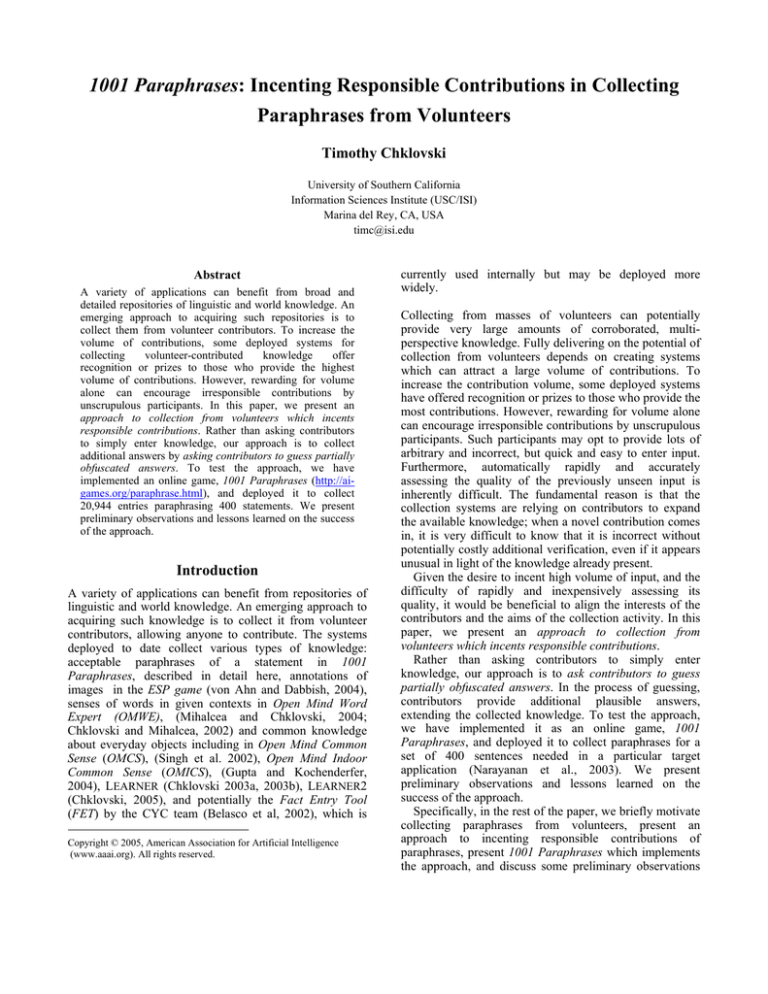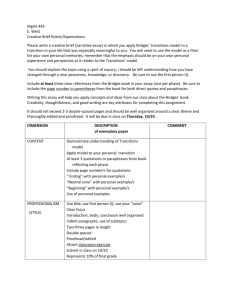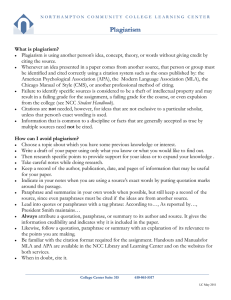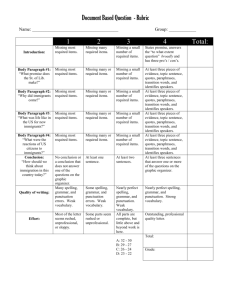
1001 Paraphrases: Incenting Responsible Contributions in Collecting
Paraphrases from Volunteers
Timothy Chklovski
University of Southern California
Information Sciences Institute (USC/ISI)
Marina del Rey, CA, USA
timc@isi.edu
Abstract
A variety of applications can benefit from broad and
detailed repositories of linguistic and world knowledge. An
emerging approach to acquiring such repositories is to
collect them from volunteer contributors. To increase the
volume of contributions, some deployed systems for
collecting
volunteer-contributed
knowledge
offer
recognition or prizes to those who provide the highest
volume of contributions. However, rewarding for volume
alone can encourage irresponsible contributions by
unscrupulous participants. In this paper, we present an
approach to collection from volunteers which incents
responsible contributions. Rather than asking contributors
to simply enter knowledge, our approach is to collect
additional answers by asking contributors to guess partially
obfuscated answers. To test the approach, we have
implemented an online game, 1001 Paraphrases (http://aigames.org/paraphrase.html), and deployed it to collect
20,944 entries paraphrasing 400 statements. We present
preliminary observations and lessons learned on the success
of the approach.
Introduction
A variety of applications can benefit from repositories of
linguistic and world knowledge. An emerging approach to
acquiring such knowledge is to collect it from volunteer
contributors, allowing anyone to contribute. The systems
deployed to date collect various types of knowledge:
acceptable paraphrases of a statement in 1001
Paraphrases, described in detail here, annotations of
images in the ESP game (von Ahn and Dabbish, 2004),
senses of words in given contexts in Open Mind Word
Expert (OMWE), (Mihalcea and Chklovski, 2004;
Chklovski and Mihalcea, 2002) and common knowledge
about everyday objects including in Open Mind Common
Sense (OMCS), (Singh et al. 2002), Open Mind Indoor
Common Sense (OMICS), (Gupta and Kochenderfer,
2004), LEARNER (Chklovski 2003a, 2003b), LEARNER2
(Chklovski, 2005), and potentially the Fact Entry Tool
(FET) by the CYC team (Belasco et al, 2002), which is
Copyright © 2005, American Association for Artificial Intelligence
(www.aaai.org). All rights reserved.
currently used internally but may be deployed more
widely.
Collecting from masses of volunteers can potentially
provide very large amounts of corroborated, multiperspective knowledge. Fully delivering on the potential of
collection from volunteers depends on creating systems
which can attract a large volume of contributions. To
increase the contribution volume, some deployed systems
have offered recognition or prizes to those who provide the
most contributions. However, rewarding for volume alone
can encourage irresponsible contributions by unscrupulous
participants. Such participants may opt to provide lots of
arbitrary and incorrect, but quick and easy to enter input.
Furthermore, automatically rapidly and accurately
assessing the quality of the previously unseen input is
inherently difficult. The fundamental reason is that the
collection systems are relying on contributors to expand
the available knowledge; when a novel contribution comes
in, it is very difficult to know that it is incorrect without
potentially costly additional verification, even if it appears
unusual in light of the knowledge already present.
Given the desire to incent high volume of input, and the
difficulty of rapidly and inexpensively assessing its
quality, it would be beneficial to align the interests of the
contributors and the aims of the collection activity. In this
paper, we present an approach to collection from
volunteers which incents responsible contributions.
Rather than asking contributors to simply enter
knowledge, our approach is to ask contributors to guess
partially obfuscated answers. In the process of guessing,
contributors provide additional plausible answers,
extending the collected knowledge. To test the approach,
we have implemented it as an online game, 1001
Paraphrases, and deployed it to collect paraphrases for a
set of 400 sentences needed in a particular target
application (Narayanan et al., 2003). We present
preliminary observations and lessons learned on the
success of the approach.
Specifically, in the rest of the paper, we briefly motivate
collecting paraphrases from volunteers, present an
approach to incenting responsible contributions of
paraphrases, present 1001 Paraphrases which implements
the approach, and discuss some preliminary observations
and lessons learned from using 1001 Paraphrases to
collect 20,944 statements from approximately 1,300
visitors to the site.
Approach
An important motivation of need for incenting responsible
contributions is evidence of irresponsible contributions
when such an incentive is not present. In deployed systems
for collecting knowledge from volunteers which reward
contributors solely based on the volume of data
contributed, there have been instances of contributors
“gaming” the system. In Open Mind Word Expert
(OMWE), a collection site on which contributors annotate
instances of words with their senses (Mihalcea and
Chklovski, 2004), a concerned contributor has contacted
the organizers asking that statements contributed from his
account be deleted. The contributor indicated that his little
brother used his account to enter a lot of low-quality data
to be rewarded for the high volume of contribution,
disregarding the notice that entries by winning contributors
will be spot-checked for quality. Another experimental
web-browser-based
knowledge
collection
activity
presented pages of multiple choice questions. Some
contributors quickly discovered that they could rapidly
increase their scores by using the browser’s back button
and re-submitting many times the same form filled out
once, further garnering high “agreement” with themselves
(Stork, 2003).
Furthermore, the more engaging and game-like the
knowledge collection interfaces become, the greater may
be the temptation for contributors to cut corners to get
ahead.
At the same time, quickly and reliably identifying
invalid contributions is made challenging by the very
nature of collecting new knowledge, because the collection
system is constantly receiving statements which it did not
already have. One approach to judging quality of
statements is to wait until other contributors also enter it.
While a statement having been entered several times may
be indicative of its reliability, a statement which has been
entered only once may still be acceptable and useful, just
rarely contributed. Another approach is to use “validating
contributors” who are presented with previously entered
statements and express whether they agree or disagree with
them. Yet, if a validating contributor disagrees with a
statement, further investigation is needed to establish
whether the original or validating contributor is to be
trusted. Despite these issues, assessing quality of
statements contributed by volunteers is important and
should be used in conjunction with the approach we
investigate here.
Rather than struggle with the contributors, we note that
it would be helpful to structure the collection activity so
that contributors try to provide responsible contributions in
the first place. To that end, we propose a simple approach
to incentivising high quality contributions. The approach is
to collect additional answers by asking contributors to
guess partially obfuscated seed or previously known
answers. The approach is applicable when a question has a
number of valid answers, as in the case of paraphrases for
a given statement or question. For each “question” or a
prompting item (in our case, the expression to be
paraphrased), the approach requires at least one valid
answer to seed the collection. Such seed answers may be
solicited from contributors separately or perhaps be the
highest precision answers automatically extracted from
text corpora. Our approach then allows collection of
additional answers.
To allow collection of novel answers completely
unrelated to the already collected answers, in our approach
as we have deployed it, each user has to make an initial
guess with the answers completely obfuscated. Since the
contributor is playing the “game” of guessing the target
answers, the contributor still has an incentive to make
plausible guesses even when the answers are completely
obfuscated.
By incorporating elements of guessing and immediate
feedback on success and failure, the approach may also be
more engaging than simply entering knowledge, although
we have not evaluated such a claim.
The approach can also be used to collect entries other
than paraphrases. For instance, it can be used to collect
answers to questions about everyday objects. To collect
such entries, a question such as “computers are used to
________” would be presented, collecting as answers such
phrases as “compose email,” “send email,” “compose
documents,” “view images” and so on. Previously
established answers can be used as targets to be guessed.
For situations in which answers are easier to guess, the
awarded score may be tied to the number of target answers
guessed correctly.
Description of 1001 Paraphrases
Natural language permits us to say nearly the same thing in
a great many ways. This variability of the surface form
without significant impact on the meaning can present
difficulties for speech recognition systems identifying what
is being said, even if only small set of commands or
queries is expected. Such variability also complicates the
task of machine translation. To address such variability for
a given expression, it can be useful to collect different
ways to paraphrase it.
Although 1001 Paraphrases is a general platform for
collecting paraphrases, it has been deployed for collecting
paraphrases for a specific research project. We introduce
this specific project, and then describe the interface,
interaction, and scoring in 1001 Paraphrases.
Specific Application of Paraphrase Collection
1001 Paraphrases has been deployed to collect training
data for a machine translation system which needs to
recognize paraphrase variants of specific target
expressions (Narayanan et al., 2003). The initial objective
of the translation system is to allow an English-speaking
doctor in a foreign country to communicate a limited
number of statements and questions to a non-English
(Persian) speaking patient. The supported communication
is limited to four hundred recognized statements, such as
“do you have a fever?” and “how long have you had these
symptoms?” The goal is to allow the doctor to say, in
English, any paraphrase of any recognized statement into a
hand-held device. The paraphrase then is to be matched to
the correct statement of the four hundred, and the prestored translation of that statement is to be output in the
output language. Due to the potential variability of the
statements, a challenging stage is to map the statement
made to the closest matching recognized statement. To
assist with this step, it is helpful to have a large corpus of
paraphrases of the allowed statements. 1001 Paraphrases
has been deployed to collect a large number of possible
paraphrases for the four hundred recognized statements.
Although the site has not been actively promoted, it has
been visited by approximately 1,300 contributors (not all
of whom played the game), and collected 20,944 distinct
paraphrases over 15 months. The recognized statements
initially came with one or two paraphrases each, a total of
400 statements and 638 additional paraphrases. These
statements and their paraphrases were used as the seeds.
Interface of 1001 Paraphrases1
The “game” consists of a contributor making multiple
attempts at guessing any of the several partially obscured
paraphrases for a displayed expression. Figure 1 shows a
screen shot of the 1001 Paraphrases interface. Displayed
at the top is the expression to be paraphrased, in this case
“this can help you”. The partially obscured target
expressions to guess are shown in the hints box. The “...”
in the hints indicates that one or more words have been
obscured.
The contributor enters a paraphrase in the box titled
“Another way to say it”. If the contributor correctly
guesses one of the paraphrases, he is awarded the amount
of points specified next to “you can win,” and the game
proceeds to the next item for paraphrasing. Otherwise, the
entered expression is added to the list of expressions
already tried by this contributor, and a larger fraction of
the words for the paraphrases to be guessed are revealed in
the hints box. The number of points you can win is also
decreased. The contributor may also choose to ask for a
hint. Just as an unsuccessful guess, this reveals more words
in the target expression, but decreases the number of points
you can win. The hint functionality has been added to
allow contributors to get more information when they
cannot think of a guess. At the same time, number of
points you can win is decreased to encourage guessing
earlier, when little information available, increasing
diversity of collected paraphrases and reflecting the
1
1001 Paraphrases is available online at http://aigames.org/paraphrase.html
Figure 1. A Screenshot of the Paraphrase Game
difficulty of guessing. The contributor can also give up;
the full answers are then revealed and a new item to
paraphrase is chosen at random from the target set. No
points are awarded or subtracted.
When a new item to paraphrase is presented, no hints
words are provided at all for the first guess. This is done to
allow collection of paraphrases which share no words with
the known paraphrases.
Selection and Obfuscation of Hints
As mentioned earlier, our approach relies on presenting
obfuscated answers. In the deployed version, how much
and exactly how the answers are obfuscated is important,
both for whether novel answers will be entered and for the
user experience. In designing the obfuscation, we aimed to
provide the setting to enter new spontaneous contributions
and to prompt contributors’ thinking rather than to
constrain it. While the hints may potentially bias new
contributions towards the ones already collected, as the
example in Figure 1 illustrates, the partial hints such as
“this could …” and “… help” for paraphrases of “this can
help you” still allow much variation in the input.
The mechanism we have selected is to show a certain
percentage of the words in the expression, replacing the
runs of omitted words with “…”. For the first guess, we do
not reveal any text of the hint, calling for a complete guess
from the contributor. For the second guess, 66% of all
words (regardless of part of speech etc) are obfuscated. For
third and subsequent guesses, 33% of all words are
obfuscated. We do not indicate the actual number of words
in the expression by design. If we did, contributors may
not enter some paraphrases because they would not “fit,”
and this self-censorship would run counter to the goal of
the collection.
Support for Entering Several Variants of a
Paraphrase at Once
In designing 1001 Paraphrases, we anticipated that it may
be frustrating to contributors to think of many variants of
paraphrases but to be able to enter only one as their guess.
Restricting the number of paraphrases a contributor can
enter is also counterproductive to the goal of the
collection. To address this issue, 1001 Paraphrases
supports compact entry of many variants of a paraphrase at
once. All the entered variants count as one guess; the
contributor wins the round if any variant matches. The
variants are entered by using special symbols, such as “/”
(for alternation), “_” (for keeping entities together in
alternations), and “(”, and “)” for enclosing optional parts
in the paraphrases. For example, entering “hello/hi there”
expands to two phrases: “hello there” and “hi there.” In
designing the language for entering multiple guesses at
once, we aimed to balance simplicity and expressiveness.
Here is a more elaborate example exercising all of the
allowed constructs:
how are_you_doing/is_it_going (today/this_morning)?
This expands to the following 6 questions:
how
how
how
how
how
how
are you doing?
are you doing today?
are you doing this morning?
is it going?
is it going today?
is it going this morning?
The contributed multi-paraphrase expressions are not used
as hints. Only instances of expansions are used as hints.
In practice, 3.8% of the contributed paraphrases used
this functionality. We speculate that many contributors
may have been unaware of this functionality, because one
had to visit the “help” page to learn about it, and server
logs indicate that few visitors did. Also, perhaps more
contributors would use this functionality to gain an edge in
their scores if the activity was made more engaging or
competitive (for example, by introducing into the game
competition against time and maintaining a high-scores
list).
all, 14,850 distinct entries were collected. By way of
illustration, Table 1 shows all the statements entered for
the statement “this will help you.” The seed paraphrases
were “this’ll help” and “this will be of help.” One
contribution was irrelevant. It contained swear words and
was accordingly discarded. Of 22 remaining new
contributions, the majority were good although some, such
as “try this” or “it’s healthy” were further off in meaning,
and one, “nice going” seems not relevant.
For longer statements, such as “we will begin the
operation as soon as we can,” majority of paraphrases were
still accurate, but some paraphrases omitted some of the
information. For example, paraphrases such as “we will be
ready soon” or “will start as soon as possible.” Although
such omissions may be undesirable in other circumstances,
they were mostly acceptable for our target application.
Paraphrase
try this
this should do the
trick
# times
contributed
# times
contributed
6
its healthy
2
5
this could be of help
1
this will help you
3
this will help
3
this should help
3
this will do the trick
3
this'll help
2
this will be of help
2
this should make it
better
this should be better
Paraphrase
this will make it
better
this could be better
this makes you feel
better
this should do
this will fix the
problem
this should fix the
problem
1
1
1
1
1
1
2
good for you
1
2
this may help
that should do the
trick
nice going
[irrelevant
contribution]
1
this can help you
2
this should help you
2
this is better
2
1
1
1
Table 1. All 26 distinct statements collected for “this
will help you.”
Preliminary Observations on Collected
Paraphrases
Examining the collected paraphrases suggests that
contributors indeed tended to make responsible
contributions. Of the contributed 20,944 paraphrases, only
0.23% contained swear words, and 0.12% were nonsense
entries. By contrast, a much larger fraction of the
statements, approximately 5%, contained misspellings.
Although the seed set contained 1,038 statements (400
distinct recognized expressions and 638 paraphrases for
them), Contributors provided many more by playing the
game. Of the 20,944 contributions, some were identical,
because different contributors made the same guesses. In
Related Work
Instead of collecting paraphrases from contributors,
paraphrases can also be extracted from texts by identifying
and aligning multiple versions of the same text (e.g. Dolan
et al., 2004) and translations of the same text (e.g., Barzilay
and Lee, 2003). While text extraction can potentially
extract a large volume of paraphrases, turning to
contributors allows focusing deeply on several selected
expressions, collective very many variants and ensuring
that many volunteers are able to generate them. Such focus
and selectable degree of validation are useful in
applications such as the limited-phrasebook machine
translation for which 1001 Paraphrases has been
deployed. At the same time, the approaches may
complement each other, with the text extraction providing
several high-confidence seed items, and/or with
paraphrases collected from volunteers being used to
bootstrap extraction from text corpora.
In the ESP game (von Ahn & Dabbish, 2004), randomly
paired contributors simultaneously enter annotations of a
selected images from the Web, with a label being acquired
when the two contributors enter the same label. Since the
goal of the game is for two contributors to guess the same
label the ESP game also encourages responsible
contributions. In the ESP game, the contributors have to
agree without additional hints. The ESP game has been
designed to generate mostly single-word labels for images.
Applying the approach to sentence-long paraphrases
without additional hints may be difficult on sentence-long
paraphrases, due to variety of paraphrases. However, it
may be interesting to explore an approach which is a
hybrid of the one we have described and of the approach
taken in ESP game, with several contributors compete on
being the first to correctly guess the paraphrase of a given
item, or with contributors guessing each others’
paraphrases by being given hints about them.
Chklovski, T. and Mihalcea, R. 2002. Building a Sense Tagged
Corpus with Open Mind Word Expert. In Proceedings of the
Workshop on "Word Sense Disambiguation: Recent Successes
and Future Directions", ACL 2002. pp. 116-122
Chklovski, T. 2003a. Using Analogy to Acquire Commonsense
Knowledge from Human Contributors, PhD thesis. MIT Artificial
Intelligence Laboratory technical report AITR-2003-002
Chklovski, T. 2003b. LEARNER: A System for Acquiring
Commonsense Knowledge by Analogy. In Proceedings of
Second International Conference on Knowledge Capture (K-CAP
2003).
Chklovski, T. 2005. Designing Interfaces for Guided Collection
of Knowledge about Everyday Objects from Volunteers. In
Proceedings of Conference on Intelligent User Interfaces (IUI05)
San Diego, CA
Dolan, W. B., Quirk, C., and Brockett, C. 2004. Unsupervised
Construction of Large Paraphrase Corpora: Exploiting Massively
Parallel News Sources. In Proceedings of COLING 2004,
Geneva, Switzerland.
Gupta, R., and Kochenderfer, M. 2004. Common sense data
acquisition for indoor mobile robots. In Nineteenth National
Conference on Artificial Intelligence (AAAI-04).
Conclusions
We have presented an approach to incent potentially
unscrupulous
volunteers
to
make
responsible
contributions. Rather than reward for pure volume, the
approach rewards for correctly guessing obfuscated
previously known answers. Preliminary analysis of
deploying the approach to collect paraphrases indicates
that a large number of novel, useful paraphrases were
indeed collected with the approach, and that there was little
evidence of non-compliant contributions.
References
Luis von Ahn and Laura Dabbish. 2004. Labeling Images with a
Computer Game. In ACM CHI 2004
Barzilay R. and Lee, L. 2003. Learning to Paraphrase: An
Unsupervised Approach Using Multiple-Sequence Alignment. In
Proc. of NAACL-HLT, 2003.
Belasco, A., Curtis, J., Kahlert, R., Klein, C., Mayans, C.,
Reagan, P. 2002. Representing Knowledge Gaps Effectively. In
Practical Aspects of Knowledge Management, (PAKM), Vienna,
Austria, December 2-3.
Mihalcea, R., and Chklovski, T. 2004. Building Sense Tagged
Corpora with Volunteer Contributions over the Web. In Current
Issues in Linguistic Theory: Recent Advances in Natural
Language Processing, Nicolas Nicolov and Ruslan Mitkov (eds),
John Benjamins Publishers.
Narayanan, S., Ananthakrishnan, S., Belvin, R., Ettelaie, E.
Ganjavi, S. Georgiou, P., Hein, C., Kadambe, S., Knight, K.,
Marcu, D., Neely, H., Srinivasamurthy, N., Traum, D. and Wang,
D. 2003. Transonics: A Speech to Speech System for EnglishPersian Interactions. In Proc. IEEE ASRU.
Stork, D. 2003. Invited talk at the Workshop on Distributed and
Collaborative Knowledge Capture (DC-KCAP), held in
conjunction with the International conference on Knowledge
Capture (K-CAP 2003).






